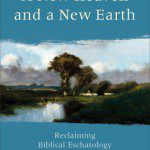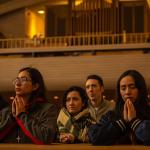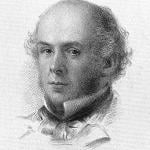Then God said, “Let us make mankind in our image, in our likeness, so that they may rule over the fish in the sea and the birds in the sky, over the livestock and all the wild animals, and over all the creatures that move along the ground.”
So God created mankind in his own image,
in the image of God he created them;
male and female he created them.God blessed them and said to them, “Be fruitful and increase in number; fill the earth and subdue it. Rule over the fish in the sea and the birds in the sky and over every living creature that moves on the ground.”
This is a familiar and foundational passage. The question of the imago Dei, the image of God is one that comes up fairly often in the conversation about evolutionary biology and Christian faith. If humankind has evolved in common descent with the other animals, cousins to apes and chimpanzees (and cats, rats, and rabbits as well) why even worry about the image of God? Evolutionary theory does away with human exceptionalism and thus with any rational concept of humans as the image of God – or so some will claim. All of those features we might identify as the image (consciousness, morality, altruism, reason, empathy, …) are found to some degree in animals as well, and a plausible case can be made for their natural evolution.
There are other reasons for interest in the imago Dei as well. Several weeks ago I put up a post The Problem of Joshua raising, but not answering, the question of how to understand the violent passages in portions of the Old Testament, especially in Deuteronomy, Joshua, and Samuel. After this post a reader sent me an e-mail suggesting some books worth considering as part of this conversation. One of these is J. Richard Middleton’s book The Liberating Image: The Imago Dei in Genesis 1, and especially the chapter Created in the Image of a Violent God. Humans are created in the image of God – but what are we to make of conception of God that “seems to enshrine violence as the quintessential divine action?” How can we develop a biblically grounded understanding of what it means to be created in the image of God?
These are big questions – and over a series of posts (likely a long series) I would like to explore the concept of the imago Dei. Middleton’s book is a good place to start. Dr. J. Richard Middleton is Professor of Biblical Worldview and Exegesis at Northeastern Seminary in Rochester New York and has specialized in the Old Testament and in creation theology among other things. In the first chapter of his book Middleton lays out what he sees as the landscape for interpretation of the Imago Dei. This is an academic book – with plenty of footnotes – and the language at times reflects this academic nature. Yet it is interesting and (with the caveat that I’ve only just begun the book) quite readable even for the educated layperson like me.
Commentary on the meaning of the phrase “image of God” has a history that extends over more than 2000 years. The interpretation of the phrase has been shaped extensively by the situation of the interpreter in time and place. Middleton outlines three major streams of thought.
The substantialist view. This is the view at work when a person poses the question “In what way are humans like God and unlike animals?” This is probably the most common approach (and one I’ve used at times) from the early church and continuing today. There is a “substance,” some capacity, that makes humans distinct. Most often the difference was identified as reason,
This notion of the rational, substantial soul mirroring its divine archetype – which is part of the pervasive influence of Platonism on Christian theology – is nuanced or supplemented in the Latin West by notions such as conscience, spirituality, immortality, freedom, and personhood and by Augustine’s famous proposal of various intrapsychic trinitarian structures (particularly memory, intellect, and will), which correspond to the triune nature of God. In the Greek east the substantialist image was often understood dynamically, as the progressive conformity of the soul to God or a salvific partaking of the divine nature, a process typically called “divinization.” (p. 19-20)
Most of us have likely thought about the concept of the image of God in manner consistent with this dominant stream of thought.
The relational interpretation. The reformation brought a new perspective to the idea of the image of God. Both Luther and Calvin, but especially Luther, have seen the image as dynamically relational. It is “ethical conformity or obedient response to God.” Luther rejected the substantialist view, but Calvin held together both a substantialist and relational view. Modern relational views of the image of God, particularly those of Karl Barth, draw upon Martin Buber’s I and Thou.
Specifically, Barth postulated two sets of relationships, ontologically constitutive for humanness, both of which image the intradivine I-Thou relationship of the triune God. … He aptly summarizes his position as follows: “The relationship between the summoning I in God’s being and the summoned Thou is reflected both in the relationship of God to the man in whom he has created, and also in the relationship between the I and the Thou between male and female, in human existence itself.” (p. 22-23)
Although the substantialist view dominates modern day-to-day thought (leaving the scholars to the side for a moment), the relational interpretation also holds traction.
The functional view. The consensus view among Old Testament scholars – those who look at text in its ancient Near Eastern context – is function. The term behind image (selem) refers most often to “a localized, visible, corporeal representation of the divine.”
When the clues within the Genesis text are taken together with comparative studies of the ancient Near East, they lead to what we could call a functional – or even missional – interpretation of the image of God in Genesis 1:26-27 (in contradistinction to substantialist or relational interpretations). On this reading, the imago Dei designates the royal office or calling of human beings as God’s representatives and agents in the world, granted authorizing power to share in God’s rule or administration of the earth’s resources and creatures. (p. 27)
The function of humankind is to image the invisible God is his creation. Middleton blames Old Testament scholars (at least in part) for the failure of this view to become more fully understood among systematic theologians and the general Christian church. The view does appear in the thinking of those who hold to a Kuyperian view of reformed theology – but even here is generally not considered in the depth it deserves. Middleton’s purpose is to examine this view more carefully along with its theological and ethical implications.
Enough for now.
Which view of the image of God most nearly resembles yours?
Does evolution pose a problem for understanding humanity as created in the image of God?
If you wish to contact me directly you may do so at rjs4mail [at] att.net.
If interested you can subscribe to a full text feed of my posts at Musings on Science and Theology.
















